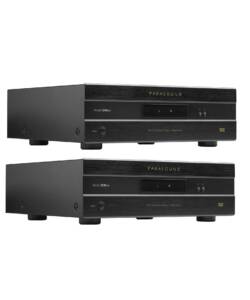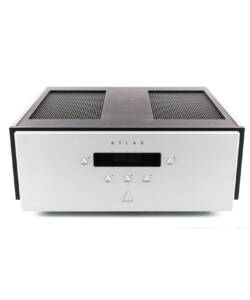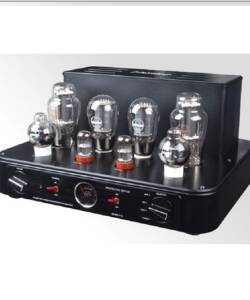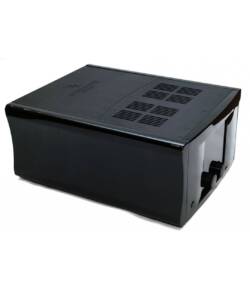Krell KAV300i Integrated Amplifier
Original price was: R60,000.00.R16,800.00Current price is: R16,800.00.
Is Krell risking its reputation? With the KAV-300i, an integrated amplifier that was originally envisaged as an export model, but for which home demand is clearly increasing, the Connecticut-based amplifier manufacturer is dabbling in low-cost territory. Previous Krell amplifiers have been known for their prodigious drive capability. Time and time again, it is found that the true measure of the bass performance of a big speaker isn’t realized until a Krell power amplifier is brought into service. But how could an amplifier with a meaty 150Wpc specification and full remote control be built to sell for just $2350.
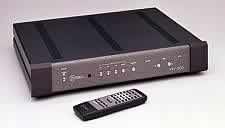 The answer lies partly in the growth of Home Theater, an area where Krell has been gaining experience with good-quality, competitively priced, multi-channel amplifiers. There was also a precedent in the KST-100, a modestly priced 100Wpc Krell power amplifier that found favor in Europe a few years back.
The answer lies partly in the growth of Home Theater, an area where Krell has been gaining experience with good-quality, competitively priced, multi-channel amplifiers. There was also a precedent in the KST-100, a modestly priced 100Wpc Krell power amplifier that found favor in Europe a few years back.
The answer also lies in backing away from Krell’s earlier design philosophy of maintaining the amplifier’s output voltage into very low impedances, 1 ohm or below. If performance is to be sustained when the load impedance halves, then, all other things being equal, the size of the amplifier power supply as well as the number of output transistors and their heatsinks must double. For Krell to specify performance down to 2 ohms and below, they must pass the costs of doing so on to the customer.
In the end, it all boils down to application. So, if you back off from the unbreakable, drive-anything amplifier-design philosophy and say, “Hey, let’s be reasonable, let’s forget those possible 1 and 2 ohm loadings, and instead target and specify for well-designed 4 and 8 ohm nominal speaker systems. Now let’s see how the design equations fall out.” The KAV-300i’s output is specified as 150Wpc into 8 ohms, doubling to 300Wpc into 4 ohms, but the amplifier is not intended to drive lower impedances. Sure, it will still be capable of frying a 3 ohm load, but you shouldn’t expect the bass slam that you get with an amplifier designed to drive lower impedances.
What you get
Krell’s literature describes the KAV-300i as belonging to their “A/V” range of products. It has significantly softer, rounder styling than the larger KSA amplifiers. It may lack macho handles, but the ‘300i is well-finished, mainly in black textured enamel, with a silver-charcoal aluminium fascia offset by black-anodized end caps. Its panel logo is the new, downward-arrow Krell “Audio-Visual” symbol.
But regardless of Krell’s philosophy or the unit’s origins, I determined to view this product as an entry-level Krell amplifier, one with an unusual combination of useful features, offered at a tempting price. You get five inputs, including the tape (monitor) facility. One input (B1) is balanced and may be configured, via an internal switch, as a direct or “through” input for an audio/video set-up, where the surround processor provides volume and balance control. (A hex wrench is supplied for getting inside, and also for replacing major fuses should this be necessary.)
Two kinds of output are available from the KAV-300i: loudspeakers are connected via one set of gold-plated five-way binding posts per channel; there is also a set of single-ended preamplifier outputs via gold-plated RCA jacks. Note that the loudspeaker terminals remain active even if the unit is run only as a preamp. This isn’t a real problem since in this mode no power need be drawn from the speaker terminals. However, speaker cables should not be left connected, in case the plugs short-circuit the amplifier outputs.
A model of simplicity, the front panel carries a horizontal line of milled, stainless-steel, circular control buttons. From the left, we have the power switch, electrically servo’d, with soft-start and standby modes. The power light glows red for standby, changing to blue for “operate.” The next five buttons deal with input selection, while the remaining two cover volume up and down. LEDs show the status of all modes—the balance offset, mute, the active input, standby/operate. In addition, a set of 11 LEDs graphically shows the volume setting.
This amplifier will mainly be operated, I expect, via the remote-control handset, a satisfactorily chunky plastic molding. As well as duplicating the power/standby, source select, and volume control buttons on the amplifier’s front panel, the remote gives the user access to the balance facility. This can be shifted unambiguously in five 1dB increments in either direction. The final touch is the inclusion of some basic control functions for a Krell-compatible CD player or transport (including many Philips-type RC5-coded units). I grew to like the handset with its dulled finish and positive-click membrane-type buttons.
The case is of aluminium alloy, and its good conductivity is exploited in the form of additional surface area for the modestly finned internal heatsinks. Though these do not have an optimum orientation, an alloy block is bolted through to the lower case section to aid heat conduction. No external fins are present, though there are some ventilation slots in the top cover. I estimate that the unit should not be run continuously at full power into 4 ohm loads for extended periods. The heatsinking is fine for normal peak program duty, however.
Inside
Inside, the compact, low-profile chassis packs a modest-looking, toroidal, steel-band-shielded transformer. This is rated at 400VA, but to a high-regulation Krell specification. (If this were not the case, that 300W into 4 ohm specification would be well out of reach.) Considerable thought has been given to protection, which in this design is by fuses (the bigger Krells use electronic protection operating via power relays). Gross short-circuit and speaker-fault protection is provided by 12A fuses at the output; these are located beneath the output terminals and user-accessible from the outside. A 12A fuse should be good for continuous full power into 2 ohms so I don’t reckon it would ever blow in normal use. There are four additional 12A fuses inside protecting the plus and minus voltage rails to each channel in case of device or circuit failure. Finally there is the AC mains fuse, which is integral with the IEC AC input receptacle.
Remarkably compact in layout, the circuitry is largely symmetrical for both channels, with a short path from input to output. It is also dual-mono from the separated transformer secondary windings onwards. The smaller, upper board is the input and control section, noteworthy for its desirably high input impedance of 210k ohms. Earlier Krell products often had rather low input load impedances, but the ‘300i will load source components lightly, even suiting D/A processors with tubed output stages. The inputs are AC-coupled using polypropylene dielectric capacitors. The potentially noisy microprocessor, complete with its own power supply, is located well away on the front panel board together with its associated buttons and LEDs.
Balanced/single-ended input conditioning is achieved with Krell’s discrete FET-input, class-A amplifier. This has a low output impedance appropriate for driving the microprocessor-programmed volume-control section. This features a precision MDAC chip (a PMI DAC8043, one per channel) used as a precision multiplying attenuator. This stage outputs a signal in current form; current/voltage conversion is accomplished by a well-respected op-amp chip, a SM2131, which feeds the resultant voltage signal to the DC-coupled stereo power amplifier stages on the lower board.
This larger board also incorporates the power supplies, which are integrated with the stereo channels. A dual winding on the transformer feeds separate rectifiers and moderate-capacity Nichicon supply reservoir capacitors, two 8200µF electrolytics per channel. Krell practice is followed for the driver-section power supplies, which use multiple paralleled reservoirs for a controlled low impedance over the audio bandwidth.
All-discrete, the power amplifier circuitry follows Krell design principles, with arrays of complementary differential stages possessing a wide bandwidth. The fully complementary output stages use custom, high-current TO3-can Motorola bipolar transistors, six per channel. These have an intrinsic peak rating of over 40A per set and are operated in class-A/B at moderate bias. The ‘300i amplifier stages employ low values of global negative feedback, reflecting current thinking that the quest by designers in earlier years for high specific damping factors and very low distortion was misguided, especially if their realization required high feedback. Although not true in all cases, it does seem that amplifiers that achieve a good overall technical performance with low global feedback sound more natural than those that rely on high feedback for linearization.

Sound
Installation was a breeze. The KAV-300i ran fairly cool and reached a stable sound quality in a matter of 10 to 15 minutes from standby. In operation, the remote control was slick and smooth-acting, with no funny noises, offering positive input selection as well as an even, wide-ranging volume control action of good resolution (just how the KPS-20i/l’s volume control should have been—see Stereophile, April ’95, Vol.18 No.4).
Serious listening commenced after a week’s conditioning and informal use. The KAV-300i turned out to be a seriously good amplifier. Fresh out of the box the ‘300i sounded promising. It could play loud and neither change in tonal character nor appear short of breath. In its raw state, however, it lacked some of the clarity and refinement which became nicely apparent after the initial 20-40 hours of use.
Writers and engineers have recently been discussing the advantages of well-designed one-box CD players with their jitter-free direct link between transport and decoder. There is a similar advantage with a single-box integrated amplifier. Not only is the signal path shortened, you also eliminate typically two soldered connections for each channel as well as a length of external cable. More importantly, you get rid of the ground currents that occur between audio separates and the audio connectors at each cable end. Knowing in advance the matching criteria for the pre- to power-amp connection, the designer doesn’t have to over-engineer the interface in expectation of a range of load problems. This may help simplify the preamp section as well as further boosting the performance of the integrated amplifier.
Provided that such an amplifier has been appropriately designed with the right components, it will show a gain in performance compared with similarly specified separates. Within its modest frame, the ‘300i did show this advantage, allowing it to rival more costly two-box combinations. For readers familiar with my personal numbering system, the KAV-300i scored 22 points (25-30 points defines top amplifier sound). For reference, Krell’s pre-1992 power amplifiers, which cost 3-4 times the price of the little ‘300i, when partnered with a suitable preamplifier, also scored ratings in the low 20s.
The KAV-300i delivered a very well-balanced sound, with no obvious errors of tone or timbre. The Krell’s midrange sounded quite rich, and if not quite to the best tube standard, it didn’t glare or shout even when operated flat-out. Overall, the midrange was relatively clear, low in grain, and fine-textured. It’s not as liquid or as transparent as a Conrad-Johnson Premier 8, an Audio Research VT150, or a Krell KAS-2, but then, very little is! (Spend a little more on your system’s cables and some of this difference can be made up.)
The soundstage had fine depth with surprisingly good transparency. The natural timbre and equally natural-sounding, well-layered perspectives were as convincing on classical music as they were on rock material. Focus was very good, stable over the entire dynamic range, and was allied to good image width. Reproduction of low-level detail and ambience were fine.
Like the mid, the KAV-300i’s treble was neutral and self-effacing, with little grain evident. It sounded unforced, with clean vocal sibilants, while cymbals were rendered both open and unexaggerated.
In the bass, the little Krell went satisfactorily deep with fine control and above-average slam. While the all-or-nothing low-frequency grip of a big KSA wasn’t present, the bass was entertaining—punchy, fast and articulate. Although it did sound slightly soft—though not tending to boominess—the amplifier’s bass timed well. It was nicely rhythmic with a foot-tapping beat. Here, the littlest Krell amplifier may just have the measure of its bigger brothers.
While the ‘300i could kick the Wilson WATT/Puppy System 5 around pretty well, this speaker really needs to be driven by bigger amplifiers like the KSA-300S or, better, Krell’s delightful KAS-2. However, you could have real fun with the ‘300i driving Wilson WITTs. Genuinely high sound levels were possible—the KAV-300i with the WITTs gave a performance which, in context, sounded surprisingly close to a KSA-200S partnering the System 5, a combination costing more than twice as much.
Dynamics were well-rendered and, in conjunction with the good rhythm and timing, gave good listener involvement. Aural fatigue was low even after prolonged listening sessions. Many times I forgot completely that my costly high-end amplification was out of the circuit! In fact, later on, when the review system was in a state of flux, it proved convenient and acceptable to throw in the ‘300i, so well did it perform in more expensive company.
Conclusion
I feel that Krell has a winner in the KAV-300i. At $2350, it may be designed to be cost-effective, but it’s a Krell thoroughbred, nonetheless, able to punch way above its weight. Not least, there is its ability on music signal to dump well over 200W per channel into an 8 ohm speaker and 300W into “kinder” 4 ohm speakers.
The versatile input facilities, the satisfactorily high-resolution volume control, and the fine infra-red remote command system are all definite pluses. Remember also the preamp output terminals—if the ‘300i is a good-sounding integrated amplifier it must also be a pretty good-sounding preamplifier!
All in all, the Krell KAV-300i offers very good dollar value and is a seriously good amplifier into the bargain. For me, it is a likely Class B contender, knocking on the door of Class A in Stereophile‘s “Recommended Components” listing. I firmly recommend it.
I’ve already written something about this famous US Company during the listening test of their smallest power amp, the Krell KAV 150 a, so if you want more infos please refer to that article or browse the Krell official web site directly.
The KAV 300i is the smallest integrated amp made by Krell though the adjective “small” isn’t well suited for this savage beast, capable of 150 watts RMS per channel on 8 ohms and 300 watts per channel on 4 ohms (I’m referring to the official specs here). Despite this brute force, the KAV 300i isn’t particularly bulky at 12 kgs (25 lbs) nor excessively oversized (47.5 x 39 x 9.25 cm).
It makes use of a single 400 VA toroidal transformer (a bit small considering the claimed output power at 4 ohms) and it offers 4 line-level inputs (1 balanced XLR, 3 standard RCA, 1 pre-out + the ubiquitous tape-loop in/out).
Probably the most interesting feature, especially for the HT crowd out there, is the so-called Theater Throughput i.e. the possibility, via an internal jumper, to switch the input labelled S3 (a standard RCA) into a “main in” so to be able to use the KAV 300i as a stereo power amplifier into a 5.1 channel Home Theater system.
On the front panel you find the volume control (switch + leds), a balance control and an input selector (relays-assisted and led-equipped). The on/off switch just leaves the amp in stand-by mode so, to turn it off completely, you need to disconnect the power cord. The amount of power consumption in stand-by mode is negligible while the amp is always ready to perform at its best.
The Krell remote allows to control other Krell components (CD players included) so, if you own a complete Krell system, you can use just a single remote. Neat.
The KAV 300i comes with a full 5 years warranty so that the customer can rest assured about the quality of the product: he who buys Krell stuff wants something designed and built to last, not a product that works well only two times a month when certain Planets are well aligned up there in the sky 😉
The KAV 300i is extremely easy to use: hook up the cables and relax, you’re going to experience a small voyage into the Krell world.
Kr…yptonite!
Having tested the KAV 150a power amp, which is very similar to the KAV 300i, I expected to get similar results in terms of sound quality. So you can just imagine my suprise when the KAV 300i started to sing into my reference system…hey! A whole different approach, indeed!!!
The KAV 300i is much more similar to a BIG Krell than to its cousin KAV 150a….a gutsier and tastier family feeling and the famous bass range to die for.
Yes, let me start to describe the bass performance of this integrated amp: I’m pretty sure you can tell it is a Krell amp by simply listening to the bass notes it reproduces: taut, authoritative, nervous and deep till the lowest end, this amp might make you discover new hidden bass frequencies on our discs. You will start to play a disc after the other just to discover new (or deeper) bass notes, especially if you were used to diminutive low-powered audiophile amps.
It is not the kind of bass range that exceeds/pollutes the rest of the audio spectrum, it actually remains clean and articulated, with no intereference with the midbass and mid range.
So what about the mid band? Definitely on the dry side and much more “focused” on the “big picture” instead of trying to pursuit the finest and subtlest detail.
Not that the KAV 300i lacks precision, it is all there, but you are lead to follow the main theme instead of analyzing those tiny-weeny details.
For example, it does succeed to make you hear the different voices of a large choir but finally you end up listening to the “unison” instead. By the way, male voices appear a bit darker than they should be.
As for acoustic instruments: drums (not cymbals), pipe organ and strings seem to be the KAV 300i ‘s preferred ones. Not so brass instruments, cymbals and other metallic percussive stuff which lack a bit of harmonic richness in the high range. A bit too “essential” in my opinion.
It seems like the KAV 300i has no time to waste to reproduce the full harmonic content of these instruments and so the sense of “air” and transparency is a bit lacking.
Micro & macrodynamics
150 watts per channel, paired with medium-sensitivity speakers, are a LOT of raw energy. If you like to listen at very high pressure levels the Krell KAV 300i may be the perfect amp for you. Perhaps your loudspeakers and/or your listening room will show their natural limits way before this amp.
A top-notch bass frequencies impact makes you believe the available energy for drums and bass lines is infinite: take the Sheffield Drum and Track record, for example. While during the most complex passages other integrated amps start to jell and squeak, the KAV 300i invites you to raise the volume louder and louder. Your speakers (and your neighbourhoods) are the limit, here 🙂
On the rest of the audio spectrum the dynamic performance is still very good and only during fortissimo‘s of very large orchestras the energy appears to be “finite”. But beware! This happens only at volume levels you and your neighbourhoods have probably never experienced in real life 🙂
The sound isn’t irresistibly fast and sometimes it appears a tad slow, because of the psychoacoustic effect of a heavyweight bass range. It is quite easy to get a lightening fast sound when the bass frequencies are lacking. Don’t you know many minimonitors are often referred as very fast though big floorstanders are known to be “slow”? Psychoacoustics is the answer.
If you don’t trust me and you preamp/amp has tone controls, try lowering the level of the bass.
The FF (“fun factor”), i.e. the ability to shake the listener’s inner soul, is one of the best characteristics of the KAV 300i. Oh yes, one may need a velvet touch instead but I’m sure you would be in trouble stopping your feet on the floor.
Definitely not recommended for those who prefer to listen to “whispers” at extremely low pressure levels, the KAV 300i is for those brave enough to want the live Music impact at home.
Soundstage
The virtual soundstage created by this amp is quite remarkable, especially because it is well extended beyond the loudspeakers. It appears a bit “dark” but the players/singers are well focused and firmly placed into it. No pin-point imaging to speak of since the lack of transparency in the upper mids and highs causes the loss of some small detail inside the scene but this is exactly what I expected by this amp, considering his tonal balance and his behaviour in the upper portion of the audio spectrum.
Some advice
As you can guess, leaving the KAV 300i permanently in stand-by mode is the best way to get its best performances. A solid and stable platform (table) and good cables will do the rest. No need to fancy exotic cables and tweaks: the KAV 300i does have a distictive kind of sound that will pop up no matter what you do with its ancillaries.
Complaints
Exactly like its cousin (KAV 150a) the cabinet of this integrated amp does have some weak spot, I mean, edgy edges 🙂 that can cause small wounds to children and pets. I’d like to see these edges on the front panel “rounded” as soon as possible.
Krell designers should consider this safety issue quite seriously, especially considering this amp doesn’t come cheap, to say the least.
The craftsmanship quality is fair while the remote control, even too complete and hence “complicated”, needs a couple of weeks of use before it becomes intuitive.
From a purely sonic point of view I’d have preferred a softer and harmonically richer sound in the mid/high range. A bit of extra transparency would be welcomed too.
Conclusions
If you want a taste of the REAL Krell sound at a human price (human considering the rated power output) then the KAV 300i may well suit your needs.
If you own lazy speakers, if you prefer visceral impact to tiny introspection, if you need a reliable, sturdly built, powerful amplifier with a first-class sound with respect to overall dynamics and quality of the bass range, well, if you need all these things…you may need to hook up a KAV 300i to your system….and don’t forget to fasten your seatbelts… 🙂
Description
Specifications
Power output: 150 watts per channel into 8Ω (stereo)
Frequency response: 1Hz to 100kHz
Total harmonic distortion: 0.3%
Signal to noise ratio: 95dB (line)
Dimensions: 475 x 387.5 x 92.5mm
Weight: 11.4kg
Accessories: remote control
Year: 2000



